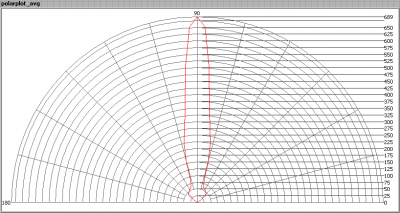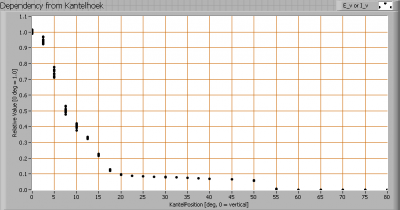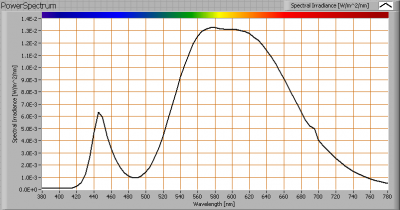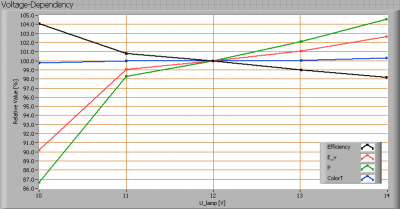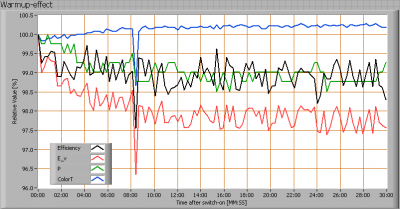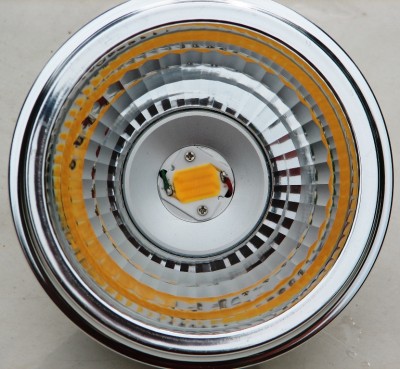A 12 V lightbulb from Line Lite International. It contains a big led chip in a big reflector case. At the back side there are 12 V mounting screws and clamps to connect to 12 V DC or AC. The light is focused and warm white.
See this overview for a comparison with other lamps.
Summary measurement results
| parameter | meas result | remark |
|---|---|---|
| Color temperature | 2850 K | Warm white. |
| Luminous Intensity Iv | 688 Cd | Bright light, not to look into. |
| Beam Angle | 15 deg | Focused beam. |
| Power P | 4.0 W | . |
| Power Factor | 0.72 | For every 1 kWh net power consumed, there has been 1 kVAhr for reactive power. |
| Luminous Flux | 211 lm | . |
| Luminous Efficacy | 53 lm/W | . |
| CRI_Ra | 69 | Color Rendering Index. |
| Coordinates Chromaticity Diagram | x=0.455 and y=0.420 | |
| Fitting | 12V | |
| Diameter | 110 mm | Outer diameter. 81 mm is the inner diameter just behind the edge of the reflector. This helps to know what hole must be drilled to mount this lightbulb. |
| Length | 72 mm | From front to ultimate extreme of 12 V clamps. |
| General remarks | The ambient temperature during the whole set of measurements was 25 deg C.
Warm up effect: not present. Voltage dependency: strong at 10 V. Raw measurement data, follow this link (brilux_ar111_12v_3w_ww.zip). The lightbulb consists of a big reflector and a big led chip, see also this photo. |
|
| Measurement report (PDF) |
E_v at 1 m distance, or I_v
Herewith the plot of the average Luminous Intensity (I_v) dependent from the inclination angle with the lamp. Average here means that all Luminous Intensities measured with different turn angles but the same inclination angle, are averaged.
The radiation pattern of the lamp.
This radiation pattern shows a beam of light which is relatively focused. Note that this graph shows the average of all light measurements done on the lamp (all turn angles averaged).
The luminous intensity dependent from the inclination angle, now with all turn angle measurements included.
A nice graph, showing a steady decrease of the luminous intensity with an increasing inclination angle. The measurements per inclination angle (with a different turn angle) are near to each other, meaning no matter what the turn angle, the intensity is about the same.
When taking the averages values, it becomes clear that at 7.5 deg the intensity is at 50 % of its value at 0 degrees. The beam angle of the light from this lamp is then 15 degrees.
The plot at the top of this paragraph shows the averaged luminous intensity values per inclination angle, which is used to compute the total luminous flux.
Luminous Flux
With the luminous intensity data as a function of the inclination angle, it is possible to compute the luminous flux.
The result of such computation for this lamp is a luminous flux of 211 lm.
Luminous efficacy
The luminous flux being 211 lm, and the power of the lamp being 4.0 W, yields a luminous efficacy of 211 / 4.0 [lm/W] = 53 lm/W.
A power factor of 0.72 means that for every 1.0 kWh net power consumed, a reactive component of 1.0 kVAr was needed.
| Lamp voltage | 12 V (AC or DC) |
| Lamp current | 461 mA |
| Power P | 4.0 W |
| Apparent power S | 5.5 VA |
| Power factor | 0.72 |
Color Temperature and Spectral Power Distribution
The spectral power distribution of this lamp.
The measured color temperature is about 2850 K, equivalent to warm white light.
Chromaticity Diagram
The chromaticity space and the position of the lamp’s color coordinates in it.
The light coming from this lamp is near the Planckian Locus (the black path in the graph). As it is not right on top of the locust itself, a correlated color temperature is computed (instead of a color temperature), which indicates to what black body radiator temperature this lamp’s light is comparable. The color temperature together with the CRI determine for what specific use this lamp is suited.
Its coordinates are x=0.455 and y=0.420.
Color Rendering Index (CRI) or also Ra
Herewith the image showing the CRI as well as how well different colors are represented. The higher the number, the better the resemblance with the color when a black body radiator would have been used (the sun, or an incandescent lamp).
Each color has an index Rx, and the first 8 indexes (R1 .. R8) are averaged to compute the Ra which is equivalent to the CRI.
CRI of the light of this lamp.
The value of 69 is lower than 80, the latter being considered a minimum value for indoor usage. This light bulb’s use is therefore not suited for general indoor use, where the light of this lamp is not capable of rendering colors about the same as a black body device at this light bulb’s correlated color temperature would render.
Note: the chromaticity difference is 0.0037 which is lower than 0.0054, which means that the calculated CRI result is meaningful. This is because the chromaticity value of this lamp is close at the Planckian Locus.
Voltage dependency
The dependency of a number of lamp parameters on the lamp voltage is determined. For this, the lamp voltage has been varied and its effect on the following lamp parameters measured: illuminance E_v [lx], color temperature CT or correlated color temperature CCT [K], the lamp power P [W] and the luminous efficacy [lm/W].
Lamp voltage dependencies of certain lamp parameters, where the value at 230 V is taken as 100 %.
The dependency on the used lamp voltage is negligible. Except for the 10 V value, where the changes are not equal to the changes at higher voltage levels. It might be correlated to the intolerance of the lamp electronics which might be known by the manufacurer or not. The same behaviour is seen with the same lightbulb that gives cold white light.
Warm up effects
After switch on of a cold lamp, the effect of heating up of the lamp is measured on illuminance E_v [lx], color temperature CT or correlated color temperature CCT [K], the lamppower P [W] and the luminous efficacy [lm/W].
Effect of heating up of the lamp on important lamp parameters.
The important parameters as illuminance and power do not show a remarkable dependency at warm up.
Lightbulb’s front side
The led chip in the center of the reflector.
This led chip is more orange than the led chip of the same lightbulb that generates cold white light.

